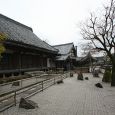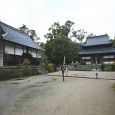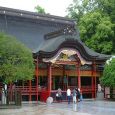Dazaifu
Advertisement
By train
Dazaifu is accessible via Futsukaichi station on the Nishitetsu Tenjin-Omuta Line.
From Tenjin station in Fukuoka there are at least a dozen trains per hour operating to Futsukaichi. The journey is 12 minutes by Limited Express or 25 minutes by Local train, and currently costs ¥390.
If you want to head from JR Hakata Station to Dazaifu, the best option is to take a local bus to Nishitetsu Yakuin Station (¥100) and there take Nishitetsu train to Dazaifu (transfer at Nishitetsu Futsukaichi). Some local buses are available from JR Futsukaichi station to Dazaifu too, but they are rather expensive and infrequent.
By car
Take the main road number 3 south out of Fukuoka, which passes through Dazaifu. This can be crushingly slow for such a short distance. A better option is to take the toll road south out of Fukuoka (you can access from various points around the city) and get off at the Dazaifu interchange, which will cost ¥600 as of May 2007.
Advertisement
Komyozenji Temple
Komyozenji is a Zen temple of the Rinzai sect of Japanese Buddhism that is located just south of Dazaifu's famous Tenmangu Shrine. The temple was founded in the middle of the Kamakura Period (1192-1333) by a disciple of the founder of Kyoto's Tofukuji Temple and belongs to the Tofukuji school of Rinzai Zen Buddhism.
Komyozenji's main attraction is its beautiful Japanese gardens. The temple has two abstract rock gardens that visitors can admire, a front garden and a rear garden. The front garden is the smaller of the two and is composed of fifteen rocks laid amongst a plot of raked pebbles. The rocks are distributed so that they form the Japanese character for "light".
Dazaifu Tenmangu Shrine
Among the hundreds of Tenmangu Shrines throughout Japan, Dazaifu's is the most important one alongside Kyoto's Kitano Tenmangu. Tenmangu Shrines are dedicated to the spirit of Sugawara Michizane, a scholar and politician of the Heian Period. Because of his great learning, Michizane has been associated with Tenjin, a Shinto deity of education, and is popular among students.
Michizane displayed his remarkable talents from a young age, and had already begun composing poetry by the age of eleven. His political career developed quickly, and he was able to gain much influence within the imperial court, which was then dominated by the Fujiwara clan. However, his rise to power resulted in rivalries between Michizane and the Fujiwara, which ultimately resulted in Michizane's exile from the capital city of Kyoto to the far-off government office of Dazaifu.
Michizane passed away in Dazaifu in 903, just a few years after being sent into exile. Shortly after his death the country was ravaged by natural disasters, and people came to believe that the calamities were caused by the wrathful spirit of Michizane, still angered by his unjust treatment. Offerings were made to the spirit of Michizane and the tradition of Tenmangu Shrines was begun. The Tenmangu Shrine in Dazaifu was built on the site of his grave.
Dazaifu Tenmangu Museum
Dazaifu Tenmangu Museum, which houses and displays many of the shrine's treasures. And behind the main hall is the small Kanko Historical Museum, which displays the main events in the life of Michizane in small dioramas. Although the signs are written in Japanese, an English pamphlet is available that has explanations for each scene.
Kyushu National Museum
When Dazaifu's Kyushu National Museum was opened in 2005 it joined the Tokyo, Kyoto, and Nara National Museums to become only the fourth national museum in the country. The other three museums were built in the late 1800s, making the opening of the Dazaifu museum quite an event. During the Nara and Heian Periods (710-1185), Dazaifu was the site of a government office that dealt with diplomatic relations with mainland Asia. The museum recognizes its host city's history by basing its exhibits on the concept of "Understanding Japanese culture from an Asian point of view".The museum building itself is a massive blue construction that resembles a sports stadium more than an exhibition space. The museum's appearance is made even more striking by the fact that it is located in a city as small as Dazaifu. Upon first entering the building visitors will surely be impressed by the spacious entrance hall. The main exhibition is on the fourth floor and is divided into five chronological sections that span Japanese history from the Prehistoric Era to the Edo Period. The sections are further divided into smaller rooms that have a unifying theme.
The museum has an impressive collection of artifacts that are presented in both a creative and informative fashion. There are also a number of small theaters displaying short movies, one of which uses impressive super-high-definition technology. Special exhibitions are displayed on the third floor and change every few months. On the first floor there is a room called the "Ajippa" with games and hands-on exhibits from various Asian cultures, that is particularly well suited for kids
Kanzeonji Temple
Kanzeonji is a temple of the Tendai sect of Japanese Buddhism. Constructed in the year 746, the temple was commissioned by an emperor in honor of his deceased mother. While Dazaifu served as the administrative center of Kyushu during the Nara and Heian Periods (710-1185), Kanzeonji was Kyushu's most important temple, but its fortunes declined when Dazaifu lost political influence.
Kanzeonji lost many of its buildings over time, including some large gates and a pagoda. The few temple buildings that still remain standing today include the main hall, the lecture hall and a bell tower. The main hall and lecture hall were most recently rebuilt in the 17th century, while the bell tower houses the oldest bell in the country, which dates back to the 7th century.
Information not available
Information not available
Advertisement







